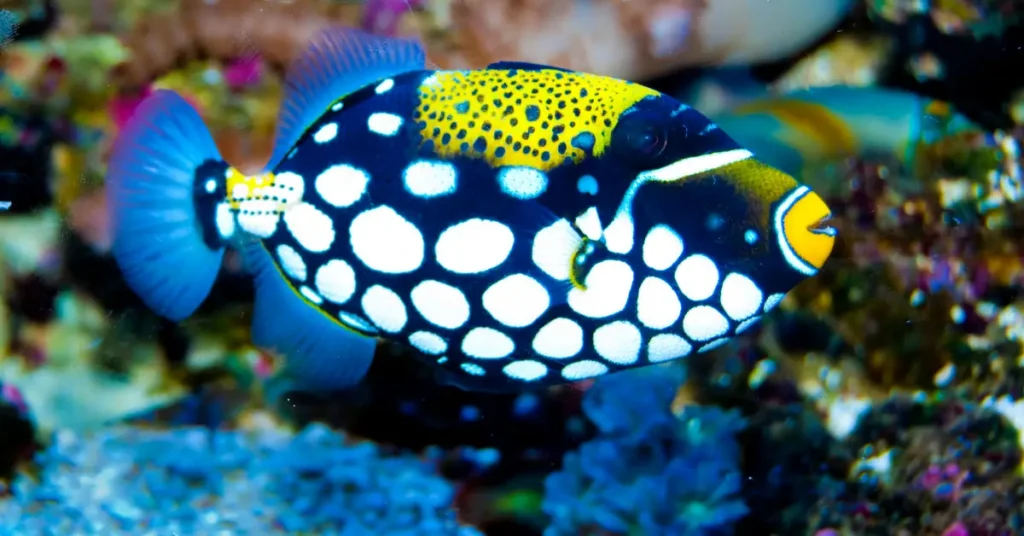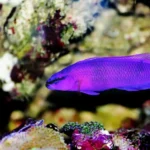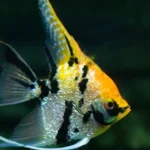Species Summary
| Scientific Name: | Balistoides conspicillum |
| Origin: | Indo-Pacific Ocean |
| Family: | Balistidae (Triggerfish) |
Appearance
Colors and Patterns
Clown Triggerfish are aptly named! Their bodies are a canvas of black with large white spots and a bright yellow tail. It’s like an artist took a black canvas, threw splatters of white paint, and finished it off with a jolt of yellow a truly unforgettable sight!
Body Shape
Clown Triggerfish have a unique, almost comical body shape. They’re laterally compressed, meaning they’re quite flat from side to side, giving them a disc-like appearance.
Their dorsal and anal fins propel them like little underwater helicopters. But the most distinctive feature is their mouth full of strong teeth—they’re not afraid to show them off!
Lifespan
With proper care, Clown Triggerfish can be your aquarium companion for a surprisingly long time! In captivity, a lifespan of 8–10 years is typical. In ideal conditions, they can even live a little longer.
Average Size
Don’t let their cute, juvenile size fool you. Clown Triggerfish grow quickly and can reach an impressive adult size of around 16-20 inches. That’s bigger than a dinner plate! This is why it’s absolutely crucial to plan for their size when choosing a tank.
Clown Triggerfish Care
Tank Size
Think big, bigger, biggest! Clown Triggerfish are active swimmers that need lots of space. A bare minimum tank size is 120 gallons, but if you can, 180 gallons or even larger is ideal. Imagine their natural coral reef home—they’re used to having the whole ocean to explore.
Water Parameters
Clown Triggerfish come from pristine tropical waters, and they expect similar conditions
in your aquarium. Aim for:
- H4: Temperature: 72-78°F (22-26°C)
- H4: pH: 8.1-8.4
- H4: Salinity: 1.020-1.025 (specific gravity)
What To Put In Their Tank
Clown Triggerfish are messy eaters and produce a lot of waste, so a powerful filtration system is vital. Beyond that, their tank setup should focus on recreating aspects of their natural reef environment while catering to their destructive tendencies.
Substrate and Rocks
A blend of sand and crushed coral provides a herbal substrate for his or her digging behavior. However, the point of interest needs to be on Stay Rock. Plenty of live rock creates a complex panorama with caves, overhangs, and crevices. This is important for Clown Triggerfish, as they like to discover and claim hiding spots.
Decorations and Hiding Places
While natural live rock is ideal, you can supplement it with artificial decorations designed for saltwater aquariums. Just be prepared for your Triggerfish to do a bit of interior design! They are notorious for rearranging anything they can get their teeth on. Stick to heavy, well-secured décor.
Important Note: Avoid anything with sharp edges or that the fish could become
trapped within. Clown Triggerfish are curious and sometimes clumsy!
Common Possible Diseases
Clown Triggerfish are generally hardy, but like all fish, they can get sick. Here are a few
common diseases to be aware of:
Ich (Marine White Spot Disease): Caused by a parasite, visible as white spots on the fish. Highly contagious and requires treatment.
- Marine Velvet: Another parasitic infection that gives the fish a dusty or velvety
appearance. - Head and Lateral Line Erosion (HLLE): Causes lesions along the fish’s head and
body. Often linked to poor water quality and diet.
The best defense is prevention! Maintain pristine water, offer a varied diet, and always quarantine new fish to reduce the risk of disease introduction.

Behavior & Temperament
Territoriality
Clown Triggerfish stake out their territory and fiercely guard it, specifically throughout breeding season. Imagine a grumpy old neighbor who yells at youngsters to get off their lawn – that’s form of like a Clown Triggerfish guarding their patch of the reef.
Aggression
Clown Triggerfish won’t hesitate to use their powerful teeth! They can bite other fish, invertebrates, and even your hand during tank maintenance. Caution and respect key.
Food & Diet
Clown Triggerfish are voracious predators with a big appetite! Their powerful teeth are designed for crunching shells and snacking on unsuspecting critters. To keep your Triggerfish are happy and healthy, focus on variety and freshness.
Food Variety
Here’s a sampling of what to offer:
- Meaty Foods: Squid, clams, mussels, shrimp (with shells on for added nutrition),
krill, chopped fish fillets. - Live Foods: Brine shrimp, feeder shrimp, and worms. These stimulate their natural
hunting instincts. - High-Quality Prepared Foods: Frozen mysis shrimp, plankton mixes designed for
carnivores. - Occasional Vegetables: Bits of seaweed (nori), blanched zucchini. This adds a little
fiber to their diet.
Feeding Tips
- Feed small, frequent meals 2-3 times a day. This helps with water quality and keeps
your Triggerfish from getting too hangry. - Use a feeding stick or tongs to avoid hand injuries.
- Be prepared for mess! Triggers are enthusiastic (and sloppy) eaters.
Clown Triggerfish Tank Mates
Choosing tank mates for a Clown Triggerfish is tricky. As a general rule, anything small enough to fit in their mouth will be viewed as a snack. Invertebrates are absolutely off the menu!
Here are some possibilities, but proceed with caution and always have a backup plan to
separate fish if needed:
- Other Semi-Aggressive Fish: Large Tangs, Angelfish, Groupers, Pufferfish. Similar
size and temperament are a must. - Some Success Stories: People have had luck with Lionfish, Eels, and even small
Sharks.
Important Considerations:
- Tank size: The larger the tank, the better the chance of (sometimes) peaceful
coexistence. - Introduce the Triggerfish last: This gives other fish time to establish territories.
- Closely monitor behavior: Be ready for rearrangements and squabbles.
Breeding
Breeding Clown Triggerfish in a home aquarium are challenging but not impossible. They
are nest builders, with the female laying eggs In a shallow pit she guards ferociously.
Spawning Triggers
Changes in water conditions and a plentiful food supply can sometimes set the stage for
breeding behavior.
Caring for Fry
If eggs hatch, raising the fry is incredibly complex, requiring specialized live feeds and rearing tanks. This is usually reserved for experienced aquarists.
Important Safety Note
While Clown Triggerfish are incredible creatures, it’s essential to acknowledge the risks
before getting one:
- Bites: Their sharp teeth can deliver a painful, even damaging, bite. Always handle
with extreme caution. Use thick gloves for tank maintenance or consider getting a
feeding stick to keep your hands out of their space. - Tank Rearranging Mayhem: Your perfectly aquascaped tank could be an interior
design disaster zone in a matter of days. Ensure all décor is heavy, secure, and won’t
topple on the fish or risk damaging your aquarium. - Escape Artists: Clown triggers are surprisingly adept at jumping. Keep your tank
securely covered!
Should You Get a Clown Triggerfish?
Clown Triggerfish are not for beginners. They require specialized care, a large investment in equipment, and a dose of bravery from their owner. However, for experienced aquarists seeking a challenge and a truly unique centerpiece fish, the Clown Triggerfish offers endless fascination.
Conclusion
Clown Triggerfish are like the dazzling divas of the saltwater aquarium world – beautiful,
demanding, and guaranteed to keep things interesting. If you’re up for the commitment,
they can bring years of enjoyment and awe-inspiring aquatic drama.
Can I keep Clown Triggerfish with other fish?
It’s possible with careful selection, a large tank, and a watchful eye. However,
many aquarists choose to keep them in a species-only tank.
Do Clown Triggerfish need live rock?
Yes! Live rock is essential for their environment, providing hiding places,
grazing opportunities, and beneficial bacteria for water quality.
Are Clown Triggerfish reef safe?
Absolutely not! They will decimate corals, invertebrates, and any fish they deem a
tasty snack.
How long do Clown Triggerfish live?
In a well-maintained aquarium, they can live for 8-10 years and sometimes
even longer.
Are Clown Triggerfish hard to keep?
They require more specialized care than many community fish. They are messy,
aggressive, and need a very large tank. They are not recommended for beginners.


